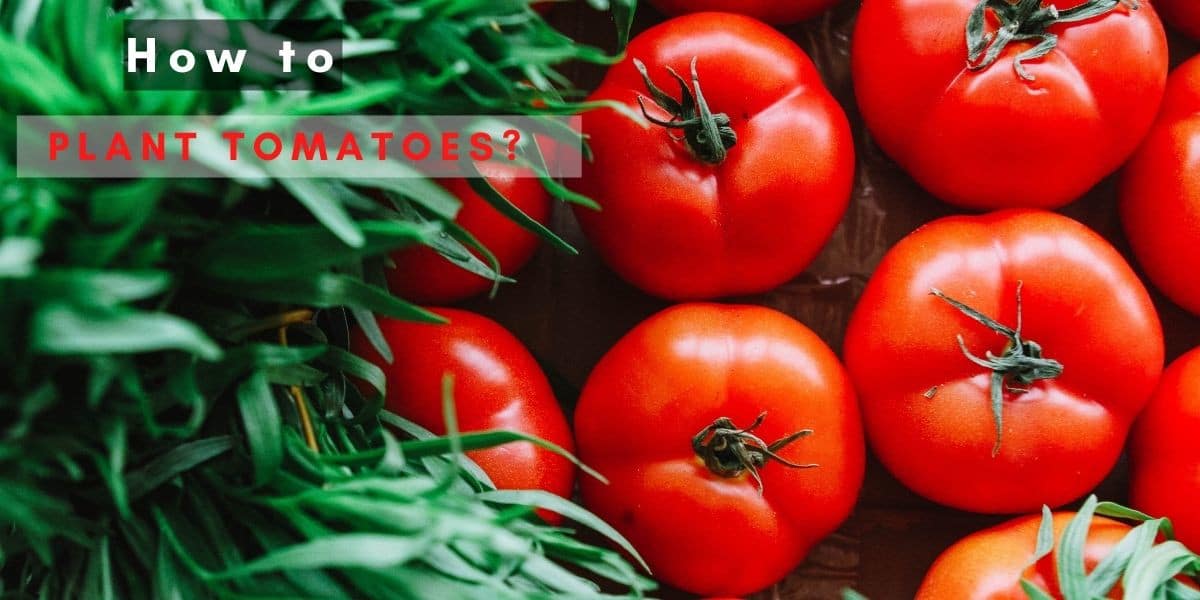How to Plant, Grow, and Harvest Tomatoes | Edible Gardening
When getting some information about how to Plant, Grow, and Harvest Tomatoes, the principal question is the way profound. Tomatoes can develop roots along their stems, so plant deep, straight up to the central arrangement of leaves when planting tomato plants. This deals with those leggy tomato seedlings. On the off chance that the plant is excessively long and flimsy, burrow a little channel and lay the plant on its side, delicately bowing it to a correct point. Cover the stem in this position uncover the initial two leaves.
A few groundskeepers accept those leggy starters will frame a better plant than those with a more minimized structure. Water your seedlings with a powerless arrangement of high phosphorus manure. Right now is an ideal opportunity to pick your help: stakes, confines, or unsupported. How far separated to plant tomato seedlings relies upon your picked support. If you choose to utilize confines or stakes, place them now, so you don’t harm the developing roots later.
Table of Contents
History Nutrition Planting Growing
Harvesting Variety Recipes Diseases
Overview Of Tomatoes
Biological Name
Solanum Lycopersicum
Plant Type
Vegetable
Maturity Period
145 days
Maturity Size
2-3 feet
Soil Type
Loamy
Soil pH
Acidic
Exposure
Full Sun
Hardiness (USDA Zone)
4-11
Spacing
75-90 x 45-60 cm
Bloom Time
late summer
Toxity
Non-Toxic
Flower Color
Yellow
Growth Rate
20-60 Days
Native Zone
South America
Maintenance
Plants ought to be around one foot separated. Prune just to the primary stem and eliminate all suckers as they create. Construct a straightforward nursery lattice by setting somewhere around four vertical help posts in the ground at the length and width you need.
History of Tomatoes
The Tomato History has beginnings followed back to the early Aztecs around 700 A.D; hence tomato was local to the Americas. At the beginning of the sixteenth century, Europeans didn’t know about this organic product, when the early voyagers set forth to find new terrains. All through Southern Europe, the tomato was immediately acknowledged into the kitchen, yet as it moved north, more opposition was evident. The British, for instance, respected the tomato for its excellence; however, they accept that it was harmful, as its appearance was like that of the wolf peach.
Nutritional Facts Of Tomatoes
- Tomatoes in the eating regimen can help secure against malignancy, keep up with solid circulatory strain, and lessen blood glucose in individuals with diabetes.
- Tomatoes contain key carotenoids like lutein and lycopene. These can secure the eye against light-actuated harm.
- Eat more tomatoes by adding them to wraps or sandwiches, sauces, or salsas. On the other hand, eat them cooked or stewed, as these arrangement techniques can support the accessibility of key supplements.
- Tomatoes are in the best ten products of the soil for containing levels of pesticide buildup. Wash tomatoes prior to eating.
How to Plant Tomatoes
When To Plant Tomatoes
Tomato seeds should have begun inside between March to June. Here’s the way to develop tomatoes in your pot garden. First, plant the tomato seeds inside in little pots 3 to 4 inches down or seed beginning plate about inches somewhere down indecently ripe soil.
Where to Plant Tomatoes
Tomatoes plants fill best in regions that get direct sun for the day. The seeds grow quickest at temperatures somewhere in the range of 70 and 80 degrees Fahrenheit. When planted in the nursery, the plants flourish in temperatures somewhere in the field of 65 and 75 degrees with six to eight hours of full sun every day.
Plant Tomatoes in Container
- Little determinate assortments are handily filled in 5-gallon (19 liters) compartments. Develop uncertain tomatoes in 10 to 15-gallon (38-57 liter) compartments.
- Spot the compartment where tomatoes get 8 hours of daylight every day.
- Give a stake, enclosure, or lattice for help at planting to keep away from the danger of harming the developing root later on.
- Keep the dirt uniformly damp. The land in compartments can dry rapidly in a sweltering climate.
- Move tomatoes in compartments inside if ice undermines. Tomatoes can be filled in cases through the colder time of year inside.
How to Grow Tomatoes
The five development phases of tomato are portrayed by Jones (2013) and García et al. (2011) as germination and early development with beginning leaves (somewhere in the range of 25 and 35 days), vegetative period (20 to 25 days), blooming (20 to 30 days), early fruiting (20 to 30 days), and develop fruiting (15 to 20 days).
Troubleshooting of Growing Tomatoes
While the infection is a typical justification for tomato plants biting the dust, the sickness isn’t the solitary thing that can kill tomato plants. Natural issues, like an absence of water, an excess of water, helpless soil, and too minimal light can likewise cause tomato plants to fall flat and kick the bucket.
Watering issues: When a tomato plant is under-watered or over-watered, it responds the same way. It will foster yellow leaves and will look withered. The ideal approach to decide whether you are under watering or over watering is to analyze the dirt. Assuming it is dry, dusty, and broke, it’s conceivable your tomatoes plant isn’t getting sufficient water. If then again, your tomato plants are in standing water or, on the other hand, if the dirt appears to be marshy, the plants might be overwatered.
Supplement issues: Poor soil regularly prompts tomato plants with hindered development and less inferior quality organic product. Plants in helpless soil are inadequate in supplements and can’t, as expected, develop without these.
Light issues: An absence of sun can additionally influence a tomato plant. Tomato plants need something like five hours of sun to endure. Not exactly this, and the plants will be hindered and pass on in the long run.
Pruning
An appropriately pruned and upheld single-stem tomato plant presents the entirety of its passes on to the sun. Most of the sugar created is coordinated to the creating natural product since the solitary rivalry is a developing solo tip.
The outcome is enormous organic products that are consistently delivered until ice. On the off chance that more stems permit to grow, a portion of the valuable sugar creation redirects from organic products to different developing tips. Natural product creation, although eased back, never stops. The outcome is an almost ceaseless stock of natural products all through the season. As a general rule, more stems imply more modest natural products, which deliver progressively later in the season.
How to Harvest Tomatoes
Harvesting Tomatoes from plant
It isn’t challenging to gather tomatoes; however, the precarious part is deciding when they are fully ready. Danielle shows Sarah three things to check for: shading, smell, and “suitability.” Red, yellow, and orange tomatoes should be dazzling red, yellow, and orange, separately; pink-fruited assortments ought to be a dusty rose tone.
Green mixtures, for example, Green Zebra, ought to be generally green, with somewhat yellow. Dark tomatoes, for example, Black Krim, ought to have a shadowy purple tone. Then, check the fragrance. The tomato should resemble a ready tomato.
Concerning suitability, squeezing a ready natural product with your finger should make a space that springs back. On the off chance that the crude product is complex, allowed it to mature some time longer. If the area stays, the organic product is overripe.
Harvest Tomatoes from Seeds
The interaction of saving tomato seeds begins with a ready, succulent tomato new off the plant. Gather tomato seeds toward the finish of the period when the organic product prepares a lot. A few groundskeepers just cut open the tomato and press the mash onto a plate or other holder.
The mash needs to dry, and afterward, you can isolate the seeds. Another strategy is to wash off the mash in a colander or screen. Still, another method for saving seeds from tomatoes mash requires a place in a glass container loaded up with water.
You can shake it and let it splash for five days. Skim off the frothy aged mash, and the seeds will be at the lower part of the container. The main piece of the way toward reaping tomato seeds is drying.
Assuming the roots aren’t as expected dried, they will form, and all your work will be pointless. Spread the seed out on paper towels to assimilate any dampness in a warm, dry area. Store the seeds until spring in a spotless glass container with a tight-fitting cover.
Seeds should be put away where it isn’t exciting to forestall invigorating their photograph receptors, which disclose to them when the time has come to develop. They might lose energy or neglect to grow in case they are presented to light.
Variety of Tomatoes
Tomatoes come in various sizes, shapes, and water content, which can assist with figuring out what kind to develop and how to utilize them. Here are probably the most widely recognized sorts:
Beefsteak tomato: Among the most effective organic products, beefsteaks have a succulent, substantial surface and good flavor. Round, somewhat straightened natural products are predominant slicers for sandwiches, mixed greens, and Caprese.
Campari tomato: Also known as tomatoes on the plant. Golf-ball-sized organic products have low causticity, uncommonly sweet flavor, and succulent surface. Useful for eating mixed greens, salsa, simmering, and bruschetta.
Pear tomato: Small pear-molded organic products have a sweet, gentle flavor and succulent surface. Plants are weighty makers for quite a while. Useful for eating, mixed greens, and jam.
Plum tomato: Popular plum tomatoes are Roma and San Marzano. The water content is low, and the surface is firm, settling on these a decent decision for pureed tomatoes, glue, simmering, drying, and canning. Organic products are smooth tasting, medium-sized, and oval-molded.
Salad tomato: Rounded organic products, 2-3 creeps in the distance across, are ideal for cutting on sandwiches or slashed in servings of mixed greens. To some degree tart and delicious, these have a decent equilibrium of corrosive and pleasantness.
Grape tomato: Like plum tomatoes, however more modest, the oval-molded natural products fill in bunches like cherry sorts yet have a thicker, meatier surface and milder flavor. Useful for eating mixed greens, kebabs, and broiling.
Cherry tomato: Bite-sized adjusted organic products that fill in groups are succulent and sweet tasting. Useful for eating mixed greens, kebabs, broiling, and speedy sauces.
Pests and Diseases
- Damping Off.
- Septoria leaf spot.
- Bacterial stem and fruit canker.
- Early blight.
- Bacterial leaf spot.
- Bacterial wilt.
- Leaf curl.
- Mosaic.
Recipes
- Tomato chutney
- Tomato rasam
- Soup
- Tomato Rice

